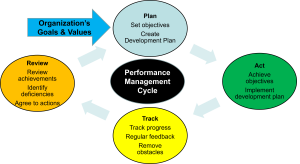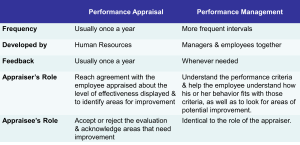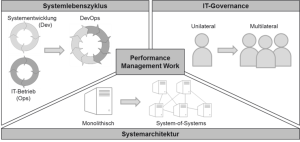7-1: Performance Management Cycle
 You’ve just started a new job, and you’re excited but also terrified. You want to do well, but nobody has really explained what “doing well” looks like. Your boss seems nice enough, but you only talk to them during brief hallway encounters where they ask “How’s it going?” and you respond with an awkward “Good!” Six months later, you sit down for your first performance review, and it feels like being called to the principal’s office. Sound familiar?
You’ve just started a new job, and you’re excited but also terrified. You want to do well, but nobody has really explained what “doing well” looks like. Your boss seems nice enough, but you only talk to them during brief hallway encounters where they ask “How’s it going?” and you respond with an awkward “Good!” Six months later, you sit down for your first performance review, and it feels like being called to the principal’s office. Sound familiar?
This scenario plays out in workplaces everywhere because many organizations still treat performance management like it’s 1985. But here’s the thing: performance management has evolved way beyond those dreaded annual reviews that nobody enjoyed giving or receiving. Today’s approach is more like having a career GPS that constantly recalculates your route to help you reach your destination.

Performance management represents a fundamental shift in how organizations approach employee development and evaluation. Unlike traditional performance reviews that often feel like court trials, performance management is a systematic approach that connects individual daily activities with organizational goals, emphasizing development and coaching over judgment.
This evolution reflects a movement from punitive approaches to positive psychology principles, viewing employees as assets to be developed rather than costs to be managed. The transformation addresses several critical purposes: clarifying expectations, enhancing performance, developing skills and capabilities, ensuring alignment with organizational direction, providing fair bases for personnel decisions, and improving manager-employee communication.
Performance Management vs. Performance Appraisal
Understanding the distinction between these concepts is crucial for career success, because they represent completely different philosophies about how people grow and improve at work.
Performance appraisal is the systematic review and evaluation of job performance, typically conducted annually or semi-annually. It’s backward-looking, focused on evaluation, and often perceived as judgmental. Think of it as taking a snapshot of the past year and saying “Here’s what you did right and wrong.” It’s like getting your report card after the semester is already over.
Performance management, conversely, is an ongoing, forward-looking process emphasizing development and coaching. This approach arose from positive psychology research, representing a shift from traditional methods that primarily focused on identifying failures rather than fostering growth. Instead of waiting until the end of the year to tell you how you did, it’s like having a coach who’s constantly helping you improve your game while you’re playing it.

The Performance Management Cycle
Performance management operates as a continuous GPS system for career development, involving three interconnected steps that cycle throughout the year. Think of it as a never-ending loop where each step feeds into the next, creating momentum for continuous improvement.
Step 1: Define Performance
The first step in the performance management cycle involves establishing clear, measurable, and aligned performance expectations. This process begins with translating organizational goals into specific objectives for departments, teams, and individuals. Managers and employees should collaborate to set SMART goals—Specific, Measurable, Achievable, Relevant, and Time-bound—that provide a roadmap for success. This alignment ensures that each employee understands how their role contributes to the broader mission of the organization, fostering a sense of purpose and direction.
Here’s where many organizations mess this up: they create vague goals like “improve customer service” or “be more proactive.” That’s like telling someone to “drive better” without explaining what that means. Effective performance definition also includes clarifying job responsibilities, expected behaviors, and success criteria. Role clarity reduces ambiguity and enhances accountability, enabling employees to focus their efforts on high-impact activities.
Research by Locke and Latham (2002) emphasizes that well-defined goals significantly enhance motivation and performance by directing attention, increasing effort, and encouraging persistence. It’s like the difference between wandering around a shopping mall aimlessly versus having a specific list of what you need to buy. By investing time in this foundational step, organizations lay the groundwork for meaningful performance measurement and feedback.
Step 2: Measurement
Effective performance management requires continuous and systematic measurement of employee progress toward defined goals. This step involves collecting both qualitative and quantitative data through various tools such as key performance indicators (KPIs), self-assessments, peer reviews, and supervisor observations. Unlike traditional annual reviews, modern systems emphasize real-time tracking and frequent check-ins to ensure that performance issues are identified and addressed promptly.
Think about it this way: if you were training for a marathon, would you wait until race day to find out how fast you’re running? Of course not! You’d track your progress throughout your training. The same principle applies to work performance. Measurement should be aligned with the specific competencies and outcomes defined in the first step, and it must be transparent and consistent across employees to maintain fairness.
Additionally, organizations are increasingly adopting multi-source feedback systems and digital dashboards to capture a holistic view of performance. These tools allow for dynamic updates and facilitate data-driven decision-making. According to DeNisi and Smith (2014), effective measurement systems not only track outcomes but also provide actionable insights that support employee development and organizational effectiveness. By integrating diverse data sources and maintaining regular documentation, organizations can ensure that performance measurement contributes meaningfully to both individual growth and strategic objectives.
Step 3: Communication
The third step in the performance management cycle centers on communication, which is essential for delivering feedback, conducting performance discussions, and planning employee development. This is where the rubber meets the road, because all the goal-setting and measuring in the world won’t help if you can’t have honest, productive conversations about performance.
Effective communication ensures that employees understand how their performance aligns with expectations and where improvements are needed. This step transforms performance management from a data collection exercise into a meaningful dialogue that fosters growth and engagement. Feedback should be timely, specific, and behavior-focused, allowing employees to make actionable changes. Managers play a critical role in creating a psychologically safe environment where employees feel comfortable receiving and responding to feedback.
According to Kluger and DeNisi (1996), feedback interventions are most effective when they focus on the task rather than the individual, as this reduces defensiveness and enhances performance. Their meta-analysis revealed that poorly delivered feedback can actually impair performance, highlighting the importance of thoughtful communication strategies. It’s the difference between saying “You’re bad at presentations” versus “When you present, try making more eye contact with the audience and slowing down your speaking pace.”
Organizations should train managers in feedback delivery techniques and encourage regular check-ins to reinforce continuous improvement. By prioritizing communication, performance management becomes a collaborative process that supports both individual development and organizational success.
Contemporary Challenges in Performance Management
The Remote Work Revolution
Let’s be honest: the shift to remote and hybrid work arrangements has fundamentally altered performance management landscapes, and not everyone has figured out how to adapt. Managers now rely on indirect information sources about employee performance, and research indicates they tend to downplay such indirect information, creating potential assessment errors.
It’s like trying to coach a basketball team when you can only see the final score but not how the game was played. You know someone scored 20 points, but you don’t know if they were good shots or if they just took 50 attempts.
However, research by Golden and Gajendran (2014) demonstrated that telecommuting can positively affect performance under appropriate conditions. Gajendran and colleagues (2015) found positive associations between remote work and both task performance and organizational citizenship behaviors, particularly when strong supervisor-employee relationships exist. The key seems to be maintaining connection and clear communication, not physical proximity.
Organizational Implications
The Society for Industrial and Organizational Psychology has identified employee engagement and organizational commitment of remote workers as top trends. The central challenge involves ensuring equivalent experiences for remote and in-office employees while maintaining competitive advantages.
This isn’t just about fairness—it’s about avoiding the creation of a two-tiered system where in-office employees get better development opportunities simply because they’re more visible to management.
Consequences of Ineffective Performance Management
Here’s something that might surprise you: bad performance management systems don’t just fail to help people improve—they actually make things worse. Poorly designed systems create cascading negative effects: inappropriate personnel decisions, employee perceptions of unfair treatment, reduced motivation and organizational commitment, increased counterproductive behaviors, job dissatisfaction, and potential legal challenges.
It’s like having a GPS that not only doesn’t help you get where you’re going but actually sends you in the wrong direction while making you feel terrible about being lost.
Effective systems require employee acceptance, careful behavioral documentation, focus on relevant performance criteria, multiple perspectives, and forward-looking improvement orientation. When you get these elements right, performance management becomes a powerful tool for individual and organizational success.

Media Attributions
- Library Economy © Jacob Coffin is licensed under a CC BY (Attribution) license
- Performance Management Cycle © Jay Brown
- Performance Management vs. Performance Appraisal
- Performance Management Framework © Jokross is licensed under a CC BY-SA (Attribution ShareAlike) license
